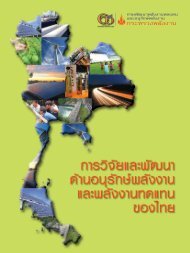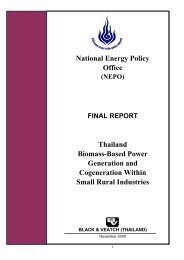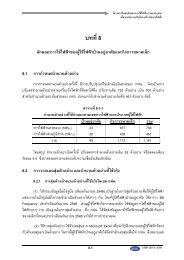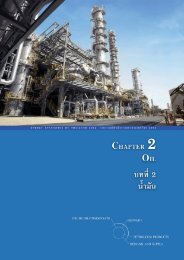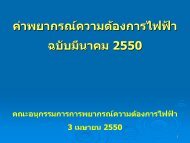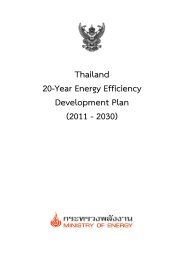à¸à¸£à¸´à¸à¸à¸² à¸à¸£à¸à¸±à¸à¸à¸£à¹ - Energy Policy and Planning Office
à¸à¸£à¸´à¸à¸à¸² à¸à¸£à¸à¸±à¸à¸à¸£à¹ - Energy Policy and Planning Office
à¸à¸£à¸´à¸à¸à¸² à¸à¸£à¸à¸±à¸à¸à¸£à¹ - Energy Policy and Planning Office
Create successful ePaper yourself
Turn your PDF publications into a flip-book with our unique Google optimized e-Paper software.
ปริญญา นรพักตร: การเพิ่มศักยภาพการผลิตกาซในหินคารบอเนตโดยการกระตุนหลุมเจาะ<br />
(INCREASING POTENTIAL OF PRODUCTION IN TIGHT GAS CARBONATE<br />
ROCK BY WELL STIMULATION) อาจารยที่ปรึกษา: ผศ. เกรียงไกร ไตรสาร, 262หนา.<br />
ISBN 974-533-226-7<br />
พลังงานจากปโตเลียม ถือไดวาเปนปจจัยที่สําคัญที่สุดปจจัยหนึ่งในการพัฒนาเศรษฐกิจของ<br />
ประเทศ การสํารวจและการพัฒนาแหลงปโตรเลียมในประเทศไทยประสบความสําเร็จพอควร ลดการ<br />
พึ่งพาปโตรเลียมจากตางประเทศ แตการสํารวจและพัฒนาแหลงปโตรเลียมในภาคตะวันออกเฉียงเหนือ<br />
ของประเทศไทยยังไมประสบความสําเร็จเทาที่ควร มีการคนพบและผลิตปโตรเลียมที่อําเภอน้ําพอง<br />
จังหวัดขอนแกนเพียงแหงเดียว และพบอีกแหลงที่อําเภอภูฮอม จังหวัดอุดรธานี แตยังไมมีการผลิต ซึ่ง<br />
ถือวานอยมากเมื่อเปรียบเทียบกับแองปโตรเลียมที่กระจัดกระจายอยูทั่วภาคตะวันออกเฉียงเหนือของ<br />
ประเทศ ซึ่งสวนใหญอยูในแหลงหินปูนยุคเพอรเมียน ความพรุน (Porosity) และความไหลผานได<br />
(Permeability) มีคานอย ทําใหผลิตลําบาก มีอัตราการผลิตนอย ดังนั้นจุดประสงคในการศึกษานี้เพื่อ<br />
ทราบคาความพรุน ความไหลผานได ของหินปูนยุคเพอรเมียนในภาคตะวันออกเฉียงเหนือ หาขอมูล<br />
พื้นฐาน ศักยภาพ ปริมาณสํารอง และประสิทธิภาพการผลิตปโตรเลียมในภาคตะวันออกเฉียงเหนือ<br />
ศึกษาผลการเพิ่มอัตราการผลิตและประสิทธิภาพการผลิตปโตรเลียมจากการกระตุนหลุมเจาะ (Well<br />
stimulation) โดยโปรแกรมที่พัฒนาขึ้นเอง เปรียบเทียบกับ แบบจําลองคอมพิวเตอรที่ใชซอฟตแวร<br />
สําเร็จรูป ซึ่งมีขั้นตอนดังนี้ 1) รวบรวมขอมูลเกี่ยวกับลักษณะของหินคารบอเนตยุคเพอรเมียน การ<br />
สํารวจ การกระตุนหลุมเจาะ และการผลิตปโตรเลียมในภาคตะวันออกเฉียงเหนือจากที่เคยมีผูศึกษามา<br />
กอน 2) วิเคราะหขอมูลหลุมเจาะเพื่อนํามาประกอบใน การศึกษา 3) เก็บตัวอยางหินที่เปนหินโผล<br />
I
(Outcrop) อยางนอย 10 ตัวอยาง และศึกษาคุณสมบัติทางฟสิกสจากหินตัวอยาง เพื่อหาความพรุนและ<br />
ความไหลผานได ในหองปฏิบัติการ 4) เขียนและพัฒนาโปรแกรมคอมพิวเตอรเพื่อคํานวณ ปริมาณกรด<br />
ที่ใช ระยะแตกของหิน ในการทําการกระตุนหลุมเจาะ อัตราการผลิตและศักยภาพการผลิตปโตรเลียม<br />
5) สรางแบบจําลองคอมพิวเตอรแหลงผลิตปโตรเลียม (Reservoir simulation) กับโปรแกรม Work Bench<br />
เพื่อหาอัตราและประสิทธิการผลิต การศึกษาในครั้งนี้ สามารถรูถึงผลการกระตุนหลุมเจาะ ในแหลงกาซ<br />
หินปูนเนื้อแนน เพื่อเพิ่มศักยภาพและอัตราการผลิตปโตรเลียมในภาคตะวันออกเฉียงเหนือของประเทศ<br />
ไทย ขอมูลที่ไดจะมีประโยชนในการวางแผนการจัดหาแหลงพลังงาน ผลการศึกษาความพรุนของหิน<br />
คารบอเนตประมาณ 4% คาความไหลผานไดกอนทําการกระตุนหลุมเจาะประมาณ 0.2 มิลลิดารซี ใช<br />
แบบจําลองปริมาณกาซ 3 แสนลานลูกบาศกฟุต หลุมผลิต 6 หลุม หลังจากทําการกระตุนหลุมเจาะโดย<br />
ใชกรด 4,440 บาเรลตอหลุม ทําใหเกิดแนวแตกเปนแนวดิ่งไกลออกจากหลุม รัศมี 540 ฟุต จะทําใหคา<br />
ความไหลผานไดเฉลี่ยในโซนของแนวแตกเปลี่ยนไปเปน 18.97 มิลลิดารซี ทําใหอัตราการผลิตเริ่มตน<br />
เพิ่มขึ้นจาก 24 เปน 73 ลานลูกบาศกฟุตตอวัน ผลการวิเคราะหเศษฐศาสตรปโตรเลียม ถาไมไดทําการ<br />
กระตุนหลุมเจาะ จะไมสามารถคืนทุนไดจากการเจาะหลุมผลิตเพิ่ม แตถาทําการกระตุนหลุมเจาะ จะ<br />
สามารถคืนทุนได โดยอัตราการคืนทุนรอยละ 18.17 สามารถคืนทุนไดในปที่ 3 ของการผลิตและผลจาก<br />
โปรแกรมที่พัฒนาขึ้นเองไดผลใกลเคียง<br />
สาขาวิชาเทคโนโลยีธรณี ลายมือชื่อนักศึกษา……………………………….<br />
ปการศึกษา 2545 ลายมือชื่ออาจารยที่ปรึกษา……………………….<br />
II
PARINYA NONRAPUG: INCREASING POTENTIAL OF PRODUCTION IN<br />
TIGHT GAS CARBONATE ROCK BY WELL STIMULATION<br />
THESIS ADVISOR: ASST.PROF. KRIANGKRAI TRISARN, M.S. 262 PP.<br />
ISBN 974-533-226-7<br />
CARBONATE ROCK/POROSITY/PERMEABILITY/WELL STIMULATION/<br />
SIMULATION<br />
The petroleum energy is the most important factor for Thail<strong>and</strong> economic<br />
development. Petroleum exploration <strong>and</strong> development in the country are moderately<br />
successful. Now we can reduce the petroleum import from abroad <strong>and</strong> can establish<br />
the stable energy supply for the economic <strong>and</strong> social development of our country. The<br />
exploration <strong>and</strong> development of the petroleum reservoirs in northeast Thail<strong>and</strong> are still<br />
not successful. Only two-gas fields are discovered. One is producing petroleum in<br />
Nam Phong district, Khon Kean province (Assavarittiprom, 1995) <strong>and</strong> the other in<br />
Phu Horm distric, Udonthani province is not producing. There are few petroleum<br />
reservoirs discovered, despite the number of potential structures in overall area of the<br />
Northeast. Most of reservoirs in the northeast are in the Permian carbonate rock<br />
(Pradidtan, 1995). The porosity <strong>and</strong> permeability of the Permian carbonate rock are<br />
very small, so production rate is low <strong>and</strong> very difficult to predict the actual<br />
performance <strong>and</strong> efficiency. The purpose of this study is to analyze carbonate rock to<br />
find porosity, reserve, production rate, <strong>and</strong> well stimulation performance. Well<br />
stimulation will be applied to the tight gas rock to increase the production rate <strong>and</strong><br />
efficiency. The methodologies for this study are as follows: 1) Compiling the porosity<br />
III
<strong>and</strong> permeability data obtained from the concessionaire results, the technical <strong>and</strong><br />
research papers, 2) Analyzing the well data for using in this study, 3) Collecting 10<br />
carbonate rock samples <strong>and</strong> measuring their porosity <strong>and</strong> permeability values in<br />
laboratory, 4) Writing <strong>and</strong> developing computer program to calculate fracturing <strong>and</strong><br />
acid fracturing performance, production rate <strong>and</strong> petroleum production efficiency<br />
(Tank model) <strong>and</strong> 5) Creating simulation model (Reservoir simulation). Therefore<br />
the expected results from this study are to improve the knowledge of well stimulation<br />
for the reservoir potential <strong>and</strong> the increase of production rate. Reservoir simulation<br />
model includes the ability to use the software approximation of the petroleum<br />
production efficiency in the northeast Thail<strong>and</strong>. Moreover, it can also be used as the<br />
reference data for studying petroleum potential <strong>and</strong> petroleum production efficiency in<br />
northeastern Thail<strong>and</strong>. The average porosity value of limestone specimen is 4%.<br />
The average permeability is 0.2 md. The reservoir model has gas in place of 300<br />
BCF. There are six production wells. The well stimulation shows fracturing radius of<br />
540 feet for 4,440 bbl of acid per well. Average permeability value at fracturing zone<br />
will change to 18.97 md with the production rate are increasing from 24 MMSCF/D to<br />
73 MMSCF/D. Result of economic analysis after well stimulation is 18.17% internal<br />
rate of return.. Pay back period will be at the third year of the production. Tank model<br />
also shows the comparable results.<br />
สาขาวิชาเทคโนโลยีธรณี<br />
ลายมือชื่อนักศึกษา………………………………..<br />
ปการศึกษา 2545 ลายมือชื่ออาจารยที่ปรึกษา………………………..<br />
IV
ACKNOWLEDGEMENTS<br />
The author wishes to acknowledge the support of the <strong>Energy</strong> <strong>Policy</strong> <strong>and</strong><br />
<strong>Planning</strong> <strong>Office</strong> Ministry of <strong>Energy</strong>.<br />
Special acknowledgements are due to Mr. Somchai Phumim <strong>and</strong> his staff for<br />
their assistance <strong>and</strong> valuable suggestions.<br />
The author is particularly indebted to his thesis advisor, Asst.Prof. Kriangkrai<br />
Trisarn who assisted in the selection of his thesis topics, effectively <strong>and</strong> patiently<br />
steered his to the right path <strong>and</strong> Miss Siree Nasakul who directed, taught <strong>and</strong> made<br />
many helpful suggestion in Black Oil Simulation of Petroleum WorkBench program.<br />
The author would like to express appreciation to his thesis committee members,<br />
Dr. Chongpan Chonglakmani, Asst. Prof. Kriangkrai Trisarn <strong>and</strong> Dr. Jirawat<br />
Chewaroungroaj.<br />
Mr. Parinya Nonrapug<br />
V
LIST OF SYMBOLS AND ABBREVIATIONS<br />
A = Annual cash flow<br />
A c = Cross section area perpendicular to fluid flow<br />
A f = Fracture area<br />
A fc = Area of filter<br />
A or A x = Cross sectional area of plug<br />
Atm / sec = Atmosphere per second<br />
B = Barrel<br />
BCF = Billion cubic feet<br />
BHP = Bottom hole pressure<br />
BP = Barometric pressure in the atmosphere unit<br />
BPD = Barrel per day<br />
BTU = British thermal unit<br />
BV = Bulk volume<br />
B g = Gas formation volume factor<br />
B o = Oil formation volume factor<br />
B w = Water formation volume factor<br />
B 1 , B 2 = Collections of terms that include saturation, PVT terms <strong>and</strong><br />
production terms<br />
VI
B<br />
n<br />
1 = Collections of terms that include saturation, PVT terms <strong>and</strong><br />
production terms at level n<br />
B<br />
n 1<br />
2<br />
+ = Collections of terms that include saturation, PVT terms <strong>and</strong><br />
CAPEX = Capital cost<br />
cp = Centipoise<br />
production terms at level n+1<br />
C = Isothermal compressibility factor, negative annual cash flow<br />
value<br />
C = Fracture fluid coefficient<br />
° C = Degree in Celsius unit<br />
D = Diameter<br />
D = Day<br />
ESCAL = Escalation<br />
f = Fanning friction factor<br />
Fac . = Facility<br />
G = Cumulative gas in place<br />
G f = Fracture gradient<br />
G P = Cumulative gas production<br />
GD = Grain density<br />
Gth = Gross thickness<br />
GOR = Gas oil ratio<br />
GV = Grain volume<br />
h = Height<br />
VII
Hh = Hydraulic horsepower<br />
HTOP = High of top structure<br />
I = Assumed value<br />
i = Discount rate<br />
Inc .Tax = Income tax<br />
IRR = Internal rate of return<br />
K gas = Overburden permeability<br />
K f = Permeability in fracture<br />
K fz = Permeability in fracture zone<br />
k g = Gas permeability<br />
k o = Oil permeability<br />
k w = Water permeability<br />
km = Overburden permeability<br />
L = Length<br />
M = Month<br />
MM = Million<br />
MMSCF / D = Million st<strong>and</strong>ard cubic feet per day<br />
MSL = Mean sea level<br />
3<br />
m = Cubic meter<br />
mm = Millimeter<br />
3<br />
mm = Cubic millimeter<br />
NPV = Net present value<br />
VIII
N Re = Reynolds number<br />
NTh = Net thickness<br />
n = Amount of year<br />
OPEC = Operating cost<br />
P = Pressure<br />
P 2 = Down stream pressure<br />
n<br />
P = Pressure at this time step<br />
n<br />
1<br />
P + = Pressure at the next time step<br />
P b = Billet equilibrated pressure<br />
P cg = Gas capillary pressure<br />
P cw = Water capillary pressure<br />
P f<br />
= Chamber equilibrated pressure<br />
P g = Gas pressure<br />
P o = Oil pressure<br />
P ob = Reference billet equilibrated pressure<br />
P of = Reference chamber pressure<br />
P os = Reference chamber with helium pressure<br />
P s<br />
= Chamber with helium equilibrated pressure<br />
P sc = Pressure at st<strong>and</strong>ard condition<br />
P w = Water pressure<br />
P 1<br />
= Upstream pressure<br />
IX
Phi = Porosity<br />
P s = Surface of injection pressure<br />
PIR = Profit to investment ratio<br />
PV = Pore volume<br />
ΔP f = The friction pressure drop Surface of injection pressure<br />
ΔP s = Hydraulic pressure<br />
Q = Flow rate<br />
q g = Gas rate<br />
r = Radius<br />
RHS i = Result of the multiplication equation on the left h<strong>and</strong> side<br />
R f = Fracture radiant<br />
SCF = St<strong>and</strong>ard cubic foot<br />
sq .km = Square-kilometer<br />
S g = Gas saturation<br />
S o = Oil saturation<br />
S w = Water saturation<br />
t = Time<br />
t s = Spending time<br />
T = Temperature<br />
T sc = Temperature at st<strong>and</strong>ard condition<br />
US $ = United State dollar<br />
Re v = Revenue<br />
X
RV = Reference volume<br />
R so = Oil saturation resistivity<br />
R sw = Water saturation resistivity<br />
W = Width of fracture<br />
V = Velocity<br />
V bil = Volume of billet removed<br />
2<br />
V bil = Volume of billets<br />
V I = Volume injection<br />
V sp = Spurt loss<br />
Z = Gas compressibility factor<br />
Δ x = Distance in x-direction<br />
Δ y = Distance in y-direction<br />
Δ z = Distance in z-direction<br />
% = Percent<br />
π = Constant value equal to 3.1416<br />
Φ ,Φ , Φ = Flux or phase potential of gas, oil <strong>and</strong> water<br />
g<br />
o<br />
w<br />
φ = Porosity<br />
φ g = Gas porosity<br />
φ o = Oil porosity<br />
φ w = Water porosity<br />
γ g = Specific Gravity of Gas<br />
∈ = Relative pipe roughness<br />
XI
ρ g = Gas density<br />
ρ o = Oil density<br />
ρ w = Water density<br />
λ g = Gas mobility<br />
λ o = Oil mobility<br />
λ w = Water mobility<br />
μair<br />
or μ N2 = Gas viscosity which varies with temperature<br />
μ g = Gas viscosity<br />
μ o = Oil viscosity<br />
μ w = Water viscosity<br />
υ = Velocity<br />
XII



